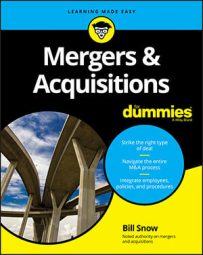Concurrent with conducting due diligence, Buyer and Seller draft a purchase agreement to memorialize the M&A deal. Although most documents during the M&A process are nonbinding (that is, generally unenforceable in a court of law), the purchase agreement is a final, binding document.
In most cases, the purchase agreement passes the baton from the investment banker, who negotiated the business deal, to the lawyer, who settles all the nits and gnats of the legal issues. Find a good attorney; you’re going to have to trust that person!
How to write an M&A purchase agreement draft
Purchase agreements don’t float in the ether, alighting to terra firma after being summoned to memorialize a deal between Buyer and Seller. Instead, someone has to write the darn things! Although both sides contribute to writing the document, someone has to provide the first draft; conventionally, that’s the Buyer, but in reality, either side can write the first draft of the purchase agreement.
In other words, Sellers shouldn’t feel compelled to wait for Buyers to provide a draft of the purchase agreement. As with most legal documents, the side that writes the agreement usually has a leg up on the other side.
In fact, you may want to have a draft of a purchase agreement written well in advance of signing a letter of intent (LOI). That way, your side can quickly claim the high ground by submitting the initial draft, and you cut down on how much you have to wade through someone else’s work.
See, the side who writes the first draft sometimes (but not always) writes an incredibly one-sided document that the other side needs to spend an inordinate amount of time fixing, tweaking, and adjusting. That is, lawyers spend that time fixing, tweaking, and adjusting, and lawyers don’t work for free (or even cheap).
Submitting a draft that’s fair and reasonable can help cut down on how long the refining process takes and reduce the associated legal fees.
Although Sellers should submit a draft, a highly motivated Seller may be wise to agree to use the Buyer’s draft if the Buyer balks at the Seller’s draft. In this case, the Seller needs to get the deal done and isn’t in much of a position to try to force the Buyer’s hand.
How to edit the M&A purchase agreement draft
No matter who provides the initial draft, the next step in the writing process involves both sides sending marked up (or redlined) versions of the purchase agreement back and forth as the lawyers work through as many issues as possible.
Keep an ear out for the term turns, which also describes the process of sending a redlined draft to the other side. You may hear something like “When will we see your turn of the purchase agreement?” in conversation with the other side.
Amazingly enough, this process often allows the lawyers to settle many of the legal issues in a purchase agreement. However, the lawyers invariably end up at loggerheads on certain issues, usually of the business variety; at this point, the deal-makers (investment bankers) need to reconnect to settle those remaining issues.
Stay on top of the lawyers’ process; after you clearly see that they’re unable to settle an issue, make sure the deal-makers speak or meet to settle the remaining open issues.

